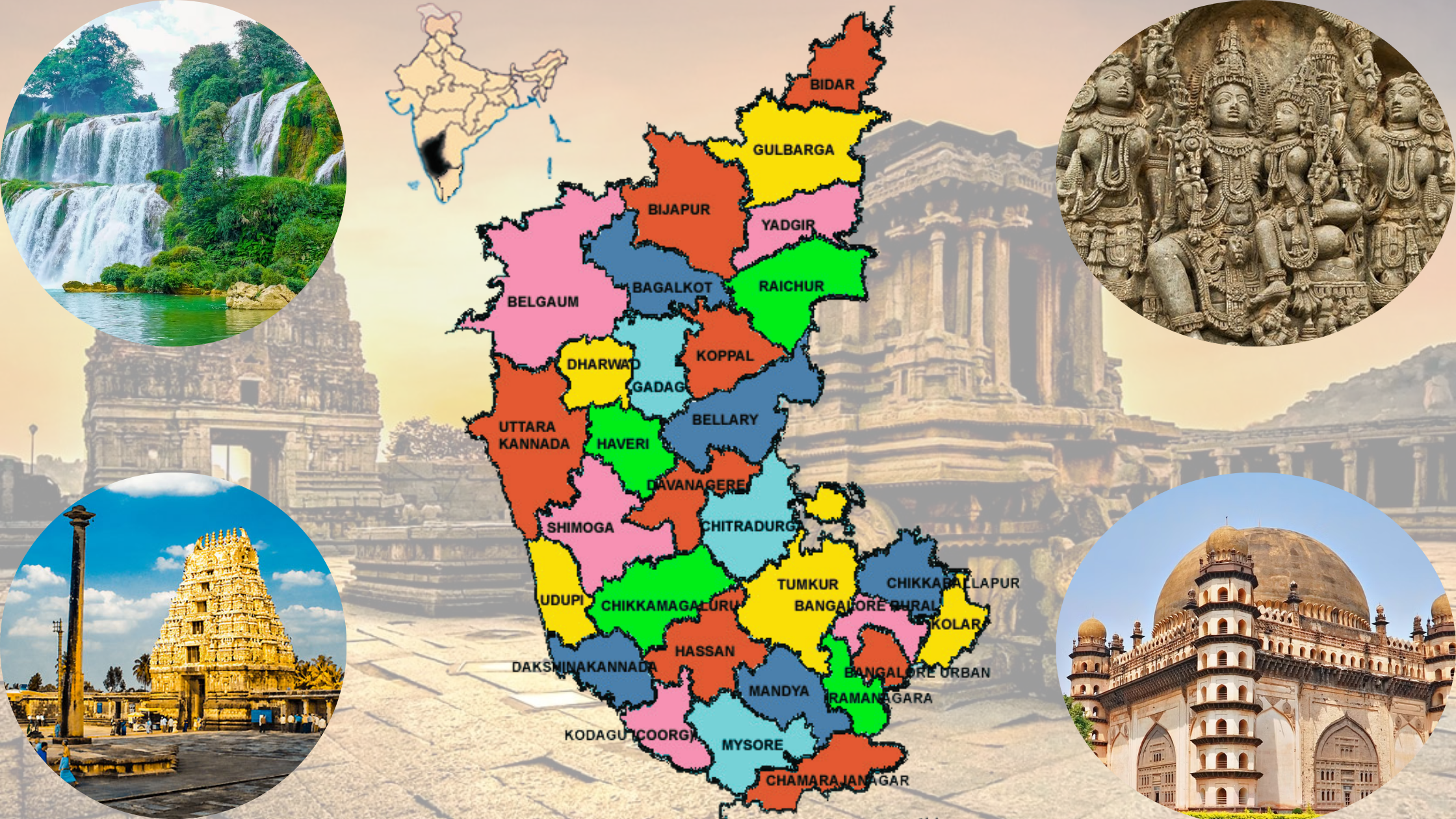Karnataka, located in the southwestern region of India, is a state rich in history, culture, and economic significance. Originally known as Mysore State, it was officially formed on November 1, 1956, following the States Reorganization Act, and later renamed Karnataka in 1973. The state shares borders with Goa, Maharashtra, Telangana, Andhra Pradesh, Tamil Nadu, and Kerala, and is flanked by the Lakshadweep Sea to the west, making it the only southern state to share land borders with all its southern neighbors.
Karnataka history is the sixth-largest state in India by area, covering 191,791 square kilometers or 5.83% of India’s geographical area. With a population of 61,130,704 as per the 2011 census, it ranks as the eighth most populous state in the country and is divided into 31 districts. The capital city, Bangalore (Bengaluru), is the state’s largest urban center and home to over 15.25 million residents. Renowned globally as the Silicon Valley of India, Bangalore is a hub for the IT industry, hosting over 1,973 IT companies as of 2007 and contributing significantly to the state’s economic growth.
Economically, Karnataka stands out as one of India’s most productive states. It boasts a Gross Domestic Product (GDP) of ₹20.5 trillion (US$260 billion) and a per capita GDP of ₹305,000 (US$3,800). The state recorded a robust Gross State Domestic Product (GSDP) growth rate of 9.5% during the 2021–22 fiscal year. Besides Bangalore Urban, districts like Dakshina Kannada, Hubli-Dharwad, and Belagavi are major revenue contributors, underscoring the diverse economic activity across the state.
Karnataka: A State of Heritage, Innovation, and Diversity
The state’s name, Karnataka, is derived from the Kannada words “karu” (elevated or black) and “nadu” (land or region), symbolizing either its elevated geography or the fertile black soil of its plains. During British rule, the term “Carnatic” or “Karnatak” was used to describe the peninsular region south of the Krishna River, encompassing parts of Karnataka and Tamil Nadu.
Karnataka’s historical legacy is unparalleled, with evidence of human habitation dating back to the Paleolithic era. Over centuries, it has been home to some of India’s most powerful empires, such as the Chalukyas, Hoysalas, and Vijayanagara Empire. These dynasties made significant contributions to art, architecture, and philosophy, leaving behind a wealth of temples, monuments, and inscriptions. The philosophers and musical bards patronized by these empires spearheaded literary and socio-religious movements that have influenced generations.
Culturally, Karnataka is a bridge between Carnatic and Hindustani music traditions, contributing immensely to both forms of Indian classical music. Kannada, one of India’s classical languages, is the official language and most widely spoken in the state. The linguistic diversity of Karnataka is remarkable, with significant communities speaking Urdu, Konkani, Marathi, Tulu, Tamil, Telugu, Malayalam, Kodava, and Beary. Uniquely, the state also has villages where Sanskrit is predominantly spoken, preserving the ancient language.
Karnataka’s geographical diversity, extending from fertile plains to hilly terrains and coastal stretches, adds to its charm. Its natural beauty, historical richness, and vibrant culture make it a unique and indispensable part of India’s legacy.
History of Karnataka
Prehistoric and Early Historic Era
Karnataka’s history dates back to prehistoric times, as evidenced by paleolithic tools such as hand axes and cleavers discovered across the region. The state’s neolithic and megalithic cultures further demonstrate its rich prehistory. Notably, gold artifacts from Karnataka have been linked to the Indus Valley Civilization, suggesting trade connections as early as 3300 BCE.
During the 3rd century BCE, Karnataka was part of the Nanda and later the Mauryan empires under Emperor Ashoka. Post-Mauryan rule saw the rise of the Satavahana dynasty, which dominated the Deccan region for four centuries, followed by the emergence of native dynasties like the Kadambas (capital at Banavasi) and Western Gangas (capital at Talakad). These were the first dynasties to use Kannada in administration, as evidenced by inscriptions like the Halmidi inscription.
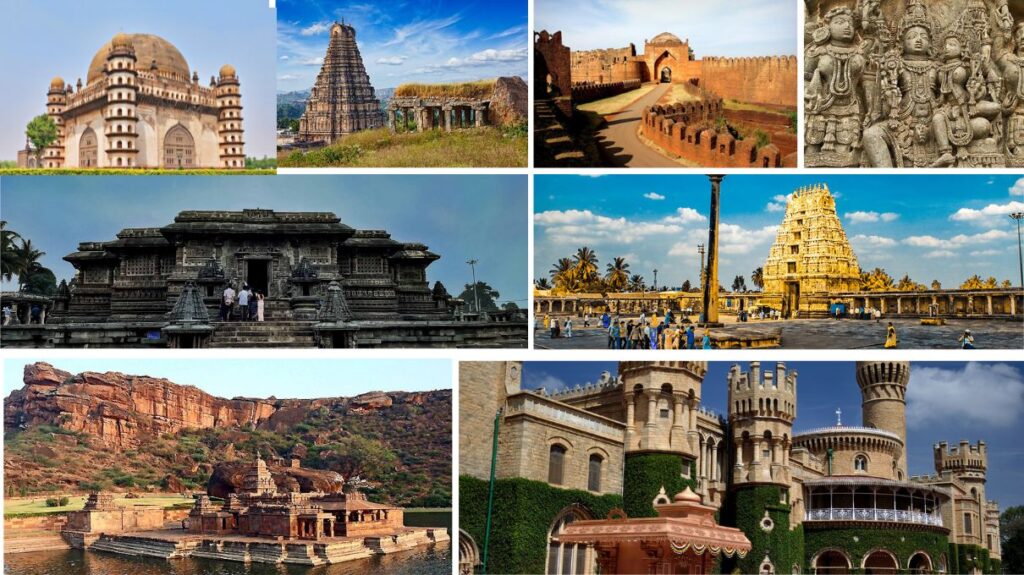
Imperial Dynasties and Medieval Period
Several powerful empires shaped Karnataka’s history during the medieval period:
- Badami Chalukyas (6th–8th Century): Renowned for their architectural achievements, including temples at Pattadakal (UNESCO World Heritage Site), the Chalukyas ruled large parts of the Deccan.

- Rashtrakuta Empire (8th–10th Century): With their capital at Manyakheta, the Rashtrakutas became one of the most significant empires of India, known for contributions to literature, art, and architecture, including the Kailasa temple at Ellora.
- Western Chalukyas (10th–12th Century): This empire introduced unique architectural styles that influenced later Hoysala art.
- Hoysalas (12th–14th Century): Emerging in the 12th century, the Hoysalas made significant contributions to literature, temple architecture, and sculpture. Their Vesara-style temples at Belur, Halebidu, and Somanathapura remain cultural landmarks.
Vijayanagar Empire (14th–16th Century)
The Vijayanagara Empire, founded by Harihara and Bukka Raya in the early 14th century, marked a golden age for Karnataka. Its capital, Vijayanagara (modern Hampi), was a hub of trade, culture, and art. Under rulers like Krishnadevaraya, Kannada literature and architecture flourished, and the empire acted as a bulwark against Muslim invasions in South India. The empire fell in 1565 after the Battle of Talikota, leading to a major geopolitical shift in the region.

Post-Vijayanagara Period
Following the decline of Vijayanagara, the Bijapur Sultanate emerged as a dominant power in Karnataka. Bijapur became known for Indo-Saracenic architecture, exemplified by the Gol Gumbaz. The Mughals later defeated Bijapur in the late 17th century. This period also saw migrations, including Konkani Hindus and Catholics from Goa, influenced by Portuguese policies.
The Mysore Kingdom, initially a vassal state under Vijayanagara, rose to prominence under leaders like Haidar Ali and Tipu Sultan in the 18th century. Their resistance to British expansion led to four Anglo-Mysore Wars, culminating in Tipu Sultan’s death in 1799. The British then restored the Wodeyar dynasty, making Mysore a princely state.
Freedom Struggle and Formation of Karnataka
Karnataka played a vital role in India’s independence movement. Early uprisings, such as those led by Kittur Chennamma and Sangolli Rayanna, showcased resistance against British colonial rule. Later, leaders like Karnad Sadashiva Rao, S. Nijalingappa, and Kengal Hanumanthaiah carried the struggle into the 20th century.
Post-independence, Mysore acceded to India, and Kannada-speaking regions were merged under the States Reorganization Act of 1956. The newly expanded state was renamed Karnataka on 1 November 1973, a date now celebrated as Karnataka Rajyotsava.
Industrialization and Modern Karnataka
In the 20th century, visionaries like Sir Mokshagundam Visvesvaraya laid the groundwork for Karnataka’s industrial and economic development. His efforts fostered advancements in engineering, infrastructure, and manufacturing, helping Karnataka become a leading state in industrial and technological innovation.
Today, Karnataka’s history stands as a testament to its resilience, cultural richness, and contributions to art, architecture, and literature, making it a significant part of India’s historical tapestry.
Geography of Karnataka
Karnataka, a diverse and geographically rich state in southern India, is renowned for its scenic landscapes, cascading waterfalls, and fertile plains. The state is divided into three principal geographical zones:
- Karavali (Coastal Region): Encompasses the lush coastal areas and Tulu Nadu.
- Malenadu (Hilly Region): Includes the Western Ghats, known for their biodiversity.
- Bayaluseeme (Plains of the Deccan Plateau): Covers a significant part of the state with semi-arid plains.

Key Features of Karnataka’s Geography
- Rivers and Waterfalls:
Karnataka’s rivers, such as the Krishna and Kaveri, provide lifelines for agriculture and hydroelectricity. The Sharavati River creates Jog Falls, India’s second-highest plunge waterfall, adding to the state’s natural allure. - Topography:
The highest point in Karnataka is Mullayanagiri Hill in the Chikmagalur district, standing at 1,925 meters (6,316 feet). Most rivers flow eastward into the Bay of Bengal, while a few, like the Sharavati and Netravati, drain westward into the Arabian Sea. - Soil and Geology:
Karnataka’s geology includes ancient Dharwad schists, Proterozoic sedimentary formations, and Deccan Trap volcanic deposits. Its soils vary from red and black soils to forest and coastal types, supporting diverse agriculture. - Forests:
About 16% of Karnataka’s land is forested, categorized into reserved and protected forests. Though lower than the national average, these forests play a crucial role in maintaining the state’s ecological balance.
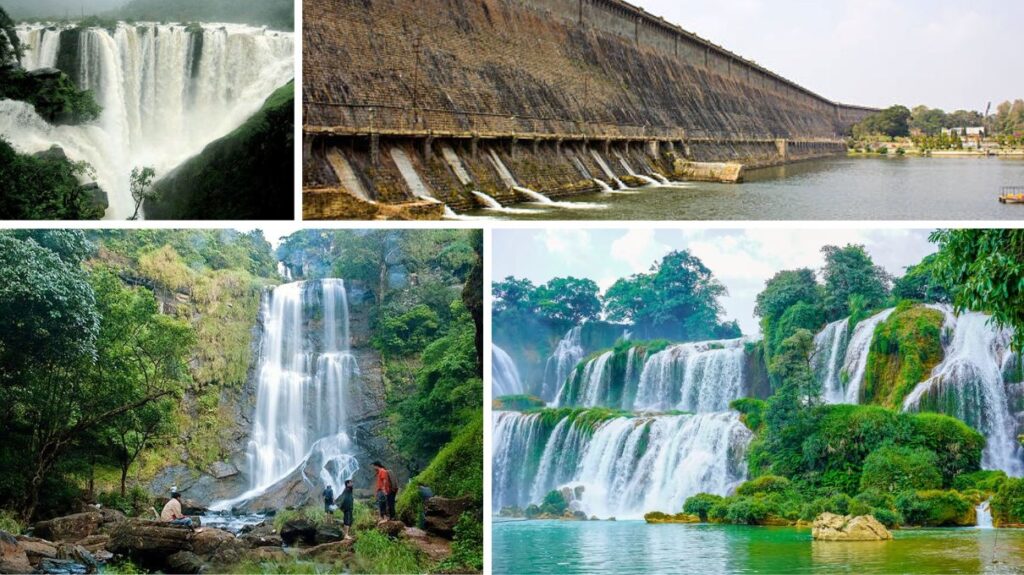
Climate of Karnataka
Karnataka experiences a diverse climate influenced by its geographical zones. The seasons are categorized into four:
- Winter: January–February
- Summer: March–May
- Monsoon: June–September
- Post-Monsoon: October–December
- Rainfall Distribution:
The coastal region receives the heaviest rainfall, averaging 3,638.5 mm annually. Agumbe and Hulikal, located in the Western Ghats, are among the rainiest places in India. Conversely, the northern plains often experience arid conditions. - Temperature:
The state’s temperatures range from a high of 45.6°C in Raichuru to a low of 2.8°C in Bidar. Projected climate changes indicate a rise in temperatures and altered monsoon patterns, posing challenges to rain-fed agriculture.

Flora and Fauna of Karnataka
Karnataka boasts a rich biodiversity, supported by its forests and the Western Ghats, a UNESCO-recognized biodiversity hotspot.
Flora
Karnataka’s forests are home to species like sandalwood (Santalum album), Garcinia cambogia, and Cinnamomum zeylanicum. The state tree, sandalwood, holds immense cultural and economic significance.
Fauna
Karnataka shelters iconic wildlife, including:
- Mammals: Bengal tigers, Indian elephants, leopards, and sloth bears.
- Birds: Indian roller (state bird), Malabar pied hornbill, and great hornbill.
- National Parks: Bandipur, Nagarahole, Bannerghatta, Kudremukh, and Anshi are among the five national parks protecting these species.
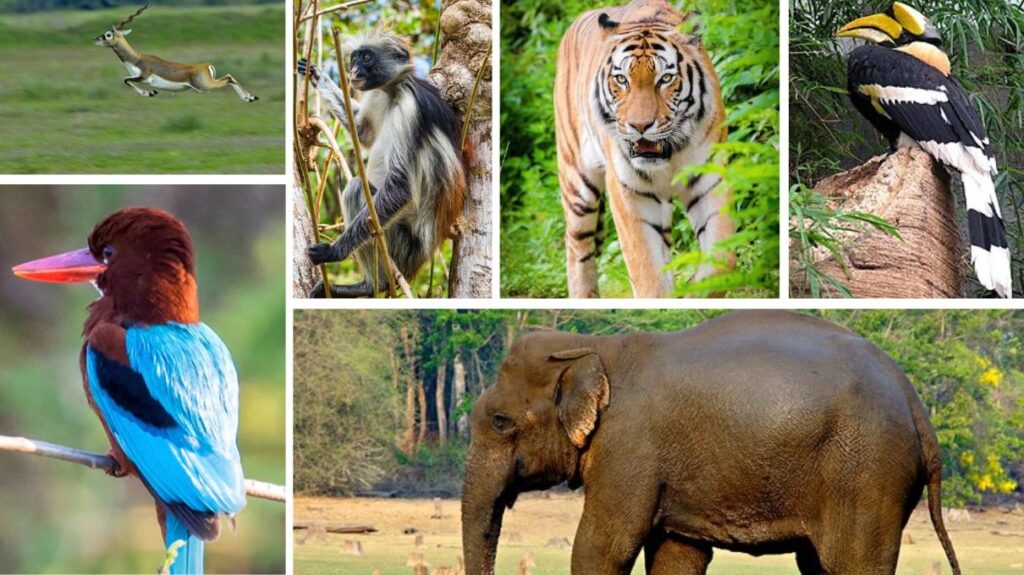
Wildlife faces threats such as poaching, habitat destruction, and human-wildlife conflict, despite conservation efforts.
Sub-divisions
Karnataka is administratively divided into 31 districts, grouped into four main divisions:
- Kitturu Karnataka Division
- Capital: Belgaum
- Includes districts like Bagalkot, Dharwad, Haveri, Uttara Kannada, and Bijapur.
- Bangalore Division
- Capital: Bangalore
- Comprises Bangalore Urban and Rural, Chitradurga, Davanagere, Tumakuru, and others.
- Kalyana Karnataka Division
- Capital: Kalaburagi
- Encompasses districts such as Bellary, Bidar, Koppal, Raichur, and Yadagiri.
- Mysore Division
- Capital: Mysore
- Covers Chamarajanagara, Dakshina Kannada, Udupi, Hassan, Kodagu, Mandya, and others.
Each district is further divided into talukas, blocks, and villages, governed by local administrative bodies like panchayats and municipal councils. Bangalore Urban stands out as the most populous district, while Mysore and Belgaum are notable for their economic and cultural significance.
Demographics
According to the 2011 Census, Karnataka’s population is 61.1 million, with a literacy rate of 75.36%. Key demographic insights include:
- Gender Ratio: 973 females per 1000 males.
- Urbanization: Approximately 38.67% of the population resides in urban areas.
- Major Cities: Bangalore (10.45 million), Mysore (920,550), and Hubballi–Dharwad (943,857) are the largest urban centers.
Karnataka’s healthcare infrastructure is notable for its private specialty hospitals and growing public health initiatives, though some rural areas face challenges in accessibility.
Religion
Karnataka is a religiously diverse state with the following distribution:
- Hinduism: 84.00%
- Islam: 12.92%
- Christianity: 1.87%
- Jainism: 0.72%
- Others: Small percentages of Sikhs, Buddhists, and non-religious communities.
Cultural and Religious Contributions:
- Hinduism: Home to major philosophies like Dvaita (Madhavaraja) and Vishisht Advaita (Ramanuja), Karnataka has played a vital role in shaping Indian spirituality. The Lingayat movement, led by Basava, was a significant reformist movement promoting equality and social justice.
- Jainism: Shravanabelagola’s Gomateshwara statue is a renowned Jain pilgrimage site.
- Islam: The Bahamani and Bijapur Sultanates brought Islamic architecture and culture to Karnataka.
- Christianity: Introduced by the Portuguese in the 16th century, it has contributed to Karnataka’s educational and healthcare sectors.
- Buddhism: Once prominent during the Mauryan era, Buddhism’s legacy persists in archaeological sites like Sannati.
Festivals
Karnataka celebrates a wide range of festivals reflecting its cultural diversity and heritage:
- Mysore Dasara:
- Known as the Nada Habba (state festival), it features a grand procession, cultural events, and rituals at the Mysore Palace.
- Bangalore Karaga:
- Celebrated in Bangalore, this ancient festival honors Draupadi and showcases vibrant processions.
- Ugadi:
- Marks the Kannada New Year and is widely celebrated with traditional rituals.
- Makara Sankranti:
- A harvest festival celebrated with kite flying and feasts.
- Other Major Festivals:
- Ganesh Chaturthi, Gowri Habba, Ram Navami, Naga Panchami, Deepavali, and Basava Jayanti are integral to Karnataka’s festive calendar.
These festivals not only uphold the religious and cultural fabric of the state but also attract visitors from across the world.

Language and Administration of Karnataka
Languages of Karnataka
Karnataka is a linguistically diverse state, with Kannada as its official language and the native tongue for 66.46% of the population as per the 2011 census. Kannada holds the prestigious title of being one of India’s classical languages, with a rich literary tradition spanning centuries. Other major languages spoken include Urdu (10.83%), Telugu (5.84%), Tamil (3.45%), Marathi (3.29%), and Tulu (2.61%). These linguistic demographics reflect the cultural and regional diversity of the state.
- Kannada Literature: Kannada boasts an ancient and vibrant literary heritage. The Halmidi inscription (450 CE) is the earliest known full-length inscription in Kannada, while the Kavirajamarga (850 CE) serves as an early literary work. Modern Kannada literature continues to thrive, with eight Jnanpith awardees from the state.
- Other Languages:
- Tulu, predominant in coastal Karnataka, is the majority language in Dakshina Kannada and Udupi districts.
- Konkani is widely spoken in Uttara Kannada and parts of Dakshina Kannada and Udupi.
- Kodava Takk, the language of the Kodavas in Kodagu district, has distinct northern and southern dialects.
- Scripts: Kannada script is widely used across regional languages like Tulu and Konkani, while the Tigalari script is historically associated with Sanskrit and Tulu.
Government and Administration
Karnataka follows a parliamentary system of governance, with a bicameral legislature consisting of the Legislative Assembly (224 members) and the Legislative Council (75 members).
- Chief Minister and Governor: The Chief Minister, chosen from the majority party in the Legislative Assembly, holds executive powers, while the Governor, appointed by the President of India, is the constitutional head.
- Representation in Parliament: Karnataka elects 28 members to the Lok Sabha and 12 members to the Rajya Sabha.
Administrative Structure
The state is divided into 31 districts, grouped under four revenue divisions, with further subdivisions into 175 taluks and 745 revenue circles. The administrative and law enforcement roles are led by:
- Deputy Commissioner (IAS) for district administration.
- Superintendent of Police (IPS) for law and order.
- Deputy Conservator of Forests (IFS) for environmental management.
Each district also manages development through dedicated departments for sectors like health, education, and public works.
Judiciary
The judiciary in Karnataka includes the Karnataka High Court, headquartered in Bangalore with circuit benches in Hubballi-Dharwad and Kalaburagi. The legal framework extends to district and session courts in each district and taluk-level lower courts.
Political Dynamics
Karnataka’s politics are dominated by the Indian National Congress, Bharatiya Janata Party, and Janata Dal (Secular). The state has contributed notable leaders to India’s federal government, including a former Prime Minister and Vice-President. However, disputes such as Karnataka’s claim over Kasaragod and Maharashtra’s claim on Belagavi continue to be contentious.
Economy of Karnataka: A Dynamic and Diverse Landscape
Karnataka is one of India’s most economically diverse and vibrant states. From agriculture to cutting-edge technology, it boasts a robust economic framework that positions it as a vital contributor to the nation’s GDP.
Gross State Domestic Product (GSDP) and Growth
Karnataka’s GSDP for the fiscal year 2014–15 was approximately $115.86 billion, accounting for 7.54% of India’s GDP. The state recorded a growth rate of 7%, demonstrating steady progress. Ranked 6th among Indian states in GDP and per capita GDP growth, Karnataka’s economic indicators reflect its balanced development strategy.

Agriculture and Rural Economy
Nearly 56% of Karnataka’s workforce is engaged in agriculture, with 64.6% of the state’s total area under cultivation. However, only 26.5% of the sown area is irrigated, making agriculture heavily reliant on the southwest monsoon. Key crops include rice, ragi, and coffee, with Karnataka being the largest producer of coffee in India.

Industrial Powerhouse
The state is home to major public sector industries such as:
- Hindustan Aeronautics Limited (HAL)
- Bharat Heavy Electricals Limited (BHEL)
- Indian Space Research Organization (ISRO)
These establishments underscore Karnataka’s dominance in aerospace, defense, and research. The Mangalore Refinery and Petrochemicals Limited and initiatives in solar energy, like the Pavagada Solar Park, further solidify its industrial base.

IT and Biotechnology Hub
Karnataka, particularly its capital Bangalore, is often referred to as the Silicon Valley of India. The IT industry in the state contributes significantly to India’s IT exports, with firms like Infosys and Wipro headquartered here. In 2006–07, exports from Karnataka’s IT sector surpassed ₹500 billion, accounting for 38% of India’s IT exports.
Additionally, the state leads in biotechnology, housing 60% of India’s biotech firms and contributing significantly to research and innovation in the sector.

Banking and Financial Services
Karnataka is a cradle for India’s banking sector, with institutions like:
- Canara Bank
- Corporation Bank
- Karnataka Bank
These banks originated in the state, making Karnataka a leader in financial inclusion and services. Coastal regions like Udupi and Dakshina Kannada boast the best bank branch distribution in India.
Silk Industry and Floriculture
Known as the Silk Capital of India, Karnataka is a major hub for silk production, particularly in Doddaballapura. Investments in a “Silk City” at Muddenahalli aim to bolster the industry further. Additionally, Karnataka’s 18,000 hectares of flower cultivation support an emerging floriculture industry that caters to domestic and international markets.

Transport: A Strong Connectivity Network
Karnataka boasts a comprehensive transportation network, connecting its diverse regions and promoting economic growth.
Air Transport
With airports in Bangalore, Mangalore, Belgaum, Hubli, Mysore, and other cities, Karnataka’s aviation sector is expanding rapidly. The Kempegowda International Airport (Bangalore) and Mangalore International Airport are pivotal in facilitating international and domestic travel. New airports in Shimoga and Bijapur under the UDAN scheme are set to further enhance connectivity.
Railways
The state has a 3,089 km-long railway network, now largely under the Southwestern Railway Zone. The Konkan Railway Zone connects Karnataka’s coastal areas to other parts of India, showcasing one of the country’s most ambitious railway projects.
Ports and Maritime Transport
Karnataka has 11 ports, including the New Mangalore Port, which is a major hub for imports, exports, and cruise tourism. The port handled 32.04 million tonnes of cargo in 2006–07 and regularly welcomes international cruise ships, boosting the state’s tourism potential.
Roadways
The state’s road network includes:
- 3,973 km of National Highways
- 9,829 km of State Highways
The Karnataka State Road Transport Corporation (KSRTC) operates alongside regional corporations like the Bangalore Metropolitan Transport Corporation (BMTC) and others, providing efficient public transport.

Culture of Karnataka
Karnataka boasts a rich and diverse cultural heritage shaped by its vibrant linguistic and religious communities, including Kannadigas, Tuluvas, Kodavas, Konkanis, and minor tribes like Soligas and Siddhis. This diversity is reflected in the state’s traditional arts, music, dance, cuisine, and festivals.
Traditional Arts and Theatre
Karnataka’s cultural identity is deeply rooted in its traditional arts. Yakshagana, a classical dance-drama from Tulu Nadu and Malnad, combines storytelling, elaborate costumes, and music, creating a mesmerizing experience. Other folk dances like Veeragase, Kamsale, Kolata, and Dollu Kunitha are vibrant representations of Karnataka’s rural traditions.
Theatre remains integral to Karnataka’s culture, with organizations like Ranga Shankara and Rangayana promoting modern and traditional plays. The contributions of theatre pioneers like Gubbi Veeranna and B. V. Karanth are celebrated across India.
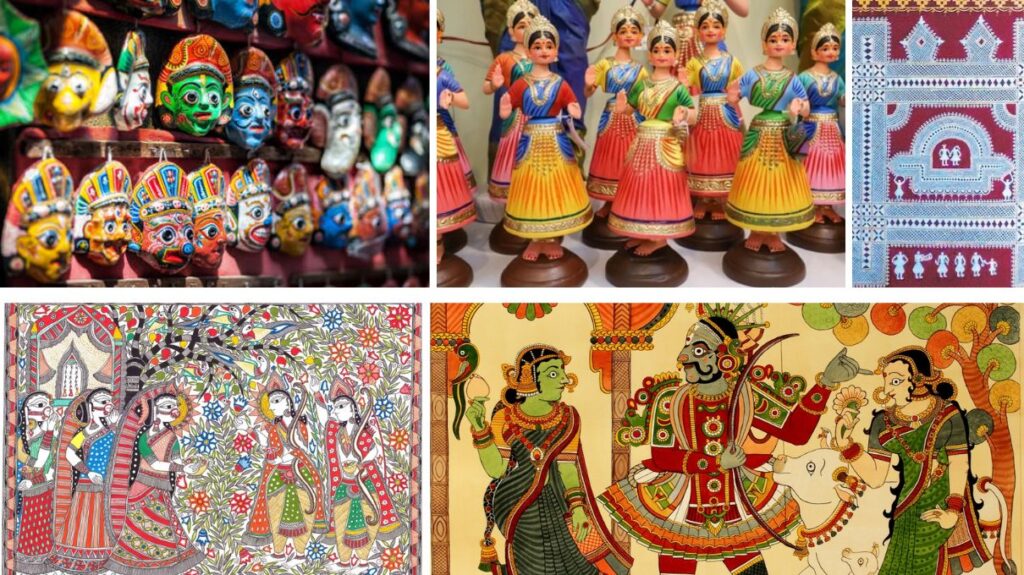
Music and Painting
Karnataka is home to both Carnatic and Hindustani classical music traditions. The Haridasa movement of the 16th century, led by saints like Purandara Dasa, profoundly influenced Carnatic music. Renowned Hindustani musicians like Gangubai Hangal and Bhimsen Joshi hail from Karnataka, leaving an indelible mark on Indian classical music.
The Mysore School of Painting is another hallmark of Karnataka’s artistic heritage, with contributions from painters like B. Venkatappa and Keshavayya. The Chitrakala Parishat in Bengaluru continues to promote the art of painting in Karnataka.
Festivals and Traditional Attire
Karnataka celebrates various festivals with fervor, including Dasara, especially in Mysore, where it is marked by grand processions and cultural programs. Ugadi, the Kannada New Year, and Karaga, a festival in Bengaluru, highlight the state’s diverse religious practices.
Traditional attire also reflects Karnataka’s cultural richness. Women often wear sarees, with distinct styles like the Kodagu drape, while men traditionally wear the Panche (dhoti) paired with the Mysore Peta or Pagadi (turban).
Culinary Heritage
Karnataka’s cuisine varies across its regions. In the south, Ragi mudde and Bisi Bele Bath are staples, while Jolada rotti dominates in the north. Coastal Karnataka is famous for its seafood and the globally acclaimed Udupi cuisine, known for its vegetarian dishes like Masala Dosa. Among sweets, Mysore Pak, Dharwad Pedha, and Karadantu are iconic.

Education in Karnataka
Karnataka stands as a hub for education in India, hosting premier institutions and a well-established school system.
Literacy and School Education
As of the 2011 census, Karnataka’s literacy rate was 75.6%, with higher male literacy (82.85%) than female literacy (68.13%). The state prioritizes universal education, supported by initiatives like the mid-day meal scheme, which boosts school attendance.
Karnataka has over 54,000 primary schools and nearly 9,500 secondary schools, offering instruction in Kannada, English, and other languages like Tulu and Konkani in certain districts.
Higher Education and Research
Karnataka is home to world-renowned institutions such as:
- Indian Institute of Science (IISc), Bengaluru
- Indian Institute of Management (IIM), Bengaluru
- National Institute of Technology Karnataka (NITK), Surathkal
- National Law School of India University (NLSIU), Bengaluru
The state also hosts 186 engineering colleges, 39 medical colleges, and 41 dental colleges, many under the jurisdiction of Visvesvaraya Technological University and Rajiv Gandhi University of Health Sciences. Institutions like Christ University and Jain University further enhance Karnataka’s reputation as a hub for private higher education.
Notable Developments
Karnataka introduced India’s first Indian Institute of Technology (IIT) in Dharwad in 2015. It also accommodates centers of Sanskrit and Vedic learning in Udupi and Sringeri, reflecting its ancient educational traditions.

Media in Karnataka
Karnataka’s media landscape is rich and diverse, reflecting the state’s cultural and linguistic heritage. The journey of Kannada newspapers began in 1843 when Hermann Mögling, a missionary, published the first Kannada newspaper, Mangaluru Samachara. Shortly thereafter, Mysuru Vrittanta Bodhini, the first Kannada periodical, was initiated by Bhashyam Bhashyacharya in Mysore.
Post-independence, Karnataka saw the establishment of major publishing houses. The Printers (Mysuru) Private Limited, founded by K.N. Guruswamy in 1948, launched Deccan Herald and Prajavani. Today, Vijay Karnataka and The Times of India dominate as the leading Kannada and English dailies, respectively. Numerous Kannada publications, including Vijayvani and Kannada Prabha, serve the local population.
Television is equally vibrant, with the state-run DD Chandana broadcasting in Kannada. Popular private channels like Colors Kannada, Zee Kannada, and Star Suvarna cater to diverse audiences.
Karnataka has a special place in Indian radio history. The first private radio station, Aakashvani, was established in 1935 in Mysore by Prof. M.V. Gopalaswamy. It was later incorporated into All India Radio (AIR) and renamed Aakashvani in 1957. The state’s FM radio network has seen tremendous growth, especially in cities like Bengaluru and Mangaluru, offering engaging local content.
Sports in Karnataka
Karnataka boasts a vibrant sports culture, excelling in hockey, cricket, and more. Kodagu, the smallest district, is renowned for its significant contribution to Indian field hockey. The annual Kodava Hockey Festival is the world’s largest hockey tournament, highlighting the region’s passion for the sport.
Cricket holds a special place in Karnataka’s sports scene. The state team has clinched the Ranji Trophy seven times. The M. Chinnaswamy Stadium in Bengaluru regularly hosts international matches and is home to the National Cricket Academy (NCA), established to nurture budding talent. The Royal Challengers Bangalore (RCB), a franchise of the Indian Premier League (IPL), represents the state on the national cricket stage.
Bengaluru is also home to franchises across various leagues, including the Bengaluru Football Club (Indian Super League), Bengaluru Bulls (Pro Kabaddi League), and Bengaluru Blasters (Premier Badminton League). The Maharaja Trophy KSCA T20 tournament, succeeding the Karnataka Premier League, showcases regional cricketing talent.

The state has produced legendary sports personalities such as:
- Cricketers: Anil Kumble, Rahul Dravid, Javagal Srinath, and K.L. Rahul
- Badminton players: Prakash Padukone and Ashwini Ponnappa
- Cue sports champions: Pankaj Advani
Cycling also has a growing footprint, particularly in Bijapur, with local athletes like Premalata Sureban gaining national recognition.
Karnataka’s sports institutions, such as the Sports Authority of India and various academies, ensure the state remains a cradle for emerging talent across disciplines.
Tourism in Karnataka
Karnataka is a treasure trove of natural beauty, cultural heritage, and architectural marvels, making it one of the top tourism destinations in India. Ranked fourth among the most visited states in the country, it offers a diverse array of attractions, from ancient temples and UNESCO World Heritage Sites to lush forests, pristine beaches, and scenic hill stations.
Architectural and Historical Sites
Karnataka boasts a rich architectural legacy with monuments spanning centuries:
- Hampi, the capital of the Vijayanagara Empire, and Pattadakal, renowned for its Chalukyan-style temples, are UNESCO World Heritage Sites.
- The Chennakesava Temple at Beluru and Hoysaleswara Temple at Halebidu are iconic examples of Hoysala architecture, crafted from soapstone.
- The Gol Gumbaz in Bijapur, with the second-largest pre-modern dome in the world, exemplifies Deccan Sultanate architecture.
- The monolithic Gomateshwara Bahubali statue at Shravanabelagola is a revered Jain pilgrimage site and the tallest sculpted monolith globally.
Natural Wonders
The state is home to some of India’s most breathtaking natural wonders:
- Jog Falls, the country’s tallest single-tiered waterfall, and other picturesque cascades such as Gokak Falls, Unchalli Falls, Abbey Falls, and Shivanasamudra Falls.
- The lush hills of Kudremukh, Madikeri, and Agumbe, which are prime eco-tourism destinations.
Karnataka also hosts 25 wildlife sanctuaries and five national parks, including:
- Bandipur National Park: Known for its tiger and elephant populations.
- Bannerghatta National Park: Famous for its wildlife safari.
- Nagarhole National Park: A part of the Nilgiri Biosphere Reserve.
Beaches and Coastal Attractions
The state’s 300-kilometer coastline is dotted with serene beaches, such as:
- Gokarna, known for its tranquil beaches and pilgrimage sites.
- Murudeshwara, featuring a towering Shiva statue by the sea.
- Karwar and Malpe, offering stunning views and water sports.
Religious Tourism
Karnataka is a major hub for religious tourism with numerous Hindu, Jain, and Christian landmarks:
- Udupi Sri Krishna Matha, Dharmasthala Manjunatha Temple, and Kukke Subramanya Temple attract thousands of devotees annually.
- Jain heritage is celebrated at Shravanabelagola, Mudabidri, and Karkala, with their ancient monuments and inscriptions.
- The Shettihalli Rosary Church, a Gothic-style Christian ruin submerged during monsoons, is a unique site of interest.
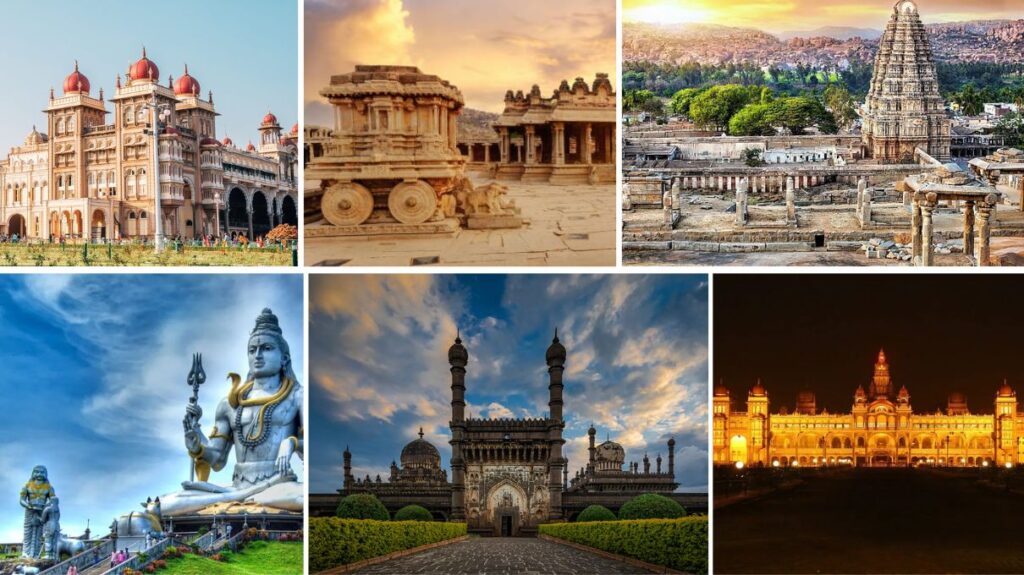
Healthcare Tourism
Karnataka has also emerged as a significant destination for healthcare tourism. With world-class private hospitals and ISO-certified government facilities, the state attracts over 8,000 health tourists annually. Alternative therapies, including Ayurveda, add to its appeal as a health tourism hub.
Conclusion
From majestic historical structures to pristine natural landscapes and spiritual retreats, Karnataka offers an unmatched blend of experiences. Whether you’re a history buff, nature lover, or spiritual seeker, the state promises a journey filled with awe and discovery.

